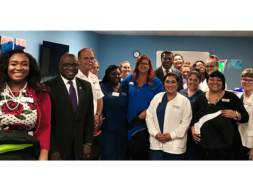
By Suzanne Morrison-Williams, EdD, Vice President, City College
Education and today’s economy
For many years the philosophy of education has been, “Build it and they will come.” Even if it wasn’t built well, didn’t always benefit the end user and was overpriced. For eons, educators have sat in their chairs of hierarchical superiority and dictated how and when education should be deployed and who was deemed good enough to receive an education. In the last few years, education has been plagued by scandal after scandal – some of them truly heinous as schools close doors leaving students holding the proverbial debt bag; while others are worthy of a Lifetime movie as we watch millionaires pay the way for their children to get into schools.
Like all good and informed school administrators, I am looking at the U.S. economy and recognizing that for the first time in over 50 years, the economy is so booming that there is no need for anyone to go to school to get a skill or re-skill themselves the way they do during a recession. This does not mean that all needed jobs are filled. It just means that people can find jobs, thereby relegating advanced education to the rubbish pile. As educators, we love a recession. We rub our hands together in glee salivating as we see displaced workers walk through our school doors in order to re-tool themselves for a new skill and/or job. Poor economies make educators and new education very relevant. We love that!
The April 2019 jobs report had the POTUS preening that 263,000 jobs were added lowering the unemployment rate to a half-century low of 3.6 percent.1
At this level of unemployment, there is no need for citizens to re-tool. Why? Because jobs are readily available. Because truth be told, no one really wants to go to school. This doesn’t mean people don’t want to learn. They just don’t want to go to school to learn. But in order to learn, school becomes a necessary evil to get consumers from Point A to a more profitable, lucrative and life-enhancing Point B.
In February 2019, I presented at the Annual ABHES conference in Savannah, GA and posed the following question to my fellow educators: So, the economy is great, now what? I kept hoping that no one expected me to have a magic answer because I don’t. But I do have some ideas based on what I’ve seen occurring in the economy and the hiring marketplace. I answered the question by doing a one-hour presentation on how to create a space for your school in a full employment economy. I explained that organizations needed to ask themselves some key questions and take a long hard look at themselves and their current practices to determine if they can remain in business with the status quo.
It is my belief that educational institutions will be forced to re-invent themselves to meet a new dynamic. The old mold of education is dying, especially when we look at our customers – both businesses and students. They are demanding very different things and if education does not change, then we will become unnecessary and extinct.
The business of education. Yes, it is a business!
Education for many years has not viewed itself as a business. It has viewed itself in a very elitist mold, and so often thought it didn’t need to answer to the whims of the economy. Educators thought that they would teach people what they need to know about the economy and business. In the meantime, the 21st century came and business and the economy was turned on its head. Products, processes and practices changed faster than education could track. This is why when millennials presented themselves in classrooms, educators were ill-equipped to handle this new and changing dynamic. Education lagged behind other industries who had recognized that it had to change to meet a changing public. Now that Gen Z is in college, schools are again faced with a new demographic and let’s hope the sector doesn’t struggle the same way it did with the prior generation.
A huge part of the education disconnect rested with schools failing to recognize that they had two clients: First, those who were consuming the education and second those who employed those who had consumed the education. Because schools failed to understand the shifting dynamic, they didn’t realize that many education consumers no longer felt the need to indebt themselves for education. Neither did they wish to spend four years pursuing an education that gave them no guarantee of a return on their investment.
Whilst schools were promoting two and four-year degrees in order to enter the marketplace, employers were merely asking for and hiring people who had skills (without the requisite degree).
The result of this dynamic is (a) declining enrollments, (b) increased and sustained marketplace job creation and (c) the continued lowering of the unemployment rate. The issue of pay is still one which needs to be addressed; however, if a consumer could spend six months learning a skill and then gain employment at essentially the same rate as a degreed person, then where’s the benefit in the degree? Answer: Nowhere!
The dilemma for education is that obtaining Title IV funding is really built upon degree attainment. The more credits in a program, the more funding is available. The funding is not necessarily tied to a skill, outcome or a given job prospect. This is where it begins to go haywire when looking at the current marketplace model and needs. Employers need employees to have a skill; but in order for a taxpayer to have access to those funds, they must be part of a program that lasts at least 15 weeks and has 24 credits. In order for schools to begin to supply the growing demands of the marketplace – it means creating shorter-term programs that fit the government’s model. What does that mean in simple language? Answer: Schools need to find a way to offer short term programs, either with or without Title IV funding that; Allows consumers to get needed skills in anywhere from six weeks to a year in order to enter the marketplace to earn competitively.
And while that sounds great on paper, in reality for a school to actually start a new program, it takes approximately 9 to 12 months to implement beginning with the curriculum.
</tr
| Curriculum Timeline | ||||
| Months 1-3 | Create curriculum, syllabi, lesson plans, textbooks, skills assessments | |||
| Months 3-6 | Submit to accrediting body and wait for approval
Maybe longer if they need a specific state board approval before submission |
|||
| Months 6-8 | Submit to the state for approval while working on marketing strategies | |||
| Months 8-9 | Receive approval, deploy marketing | |||
| Month 10-12 | Secure enrollments, start the program | |||
This process means that schools are waiting an entire year in order to meet market demands. This is contrasted with a training facility who can immediately deploy a curriculum, secure alternative loan models for students and roll out training in three to six months. They also are not hindered by specific methods of marketing because they do not fall under accreditation or state guidelines. So, while non-accredited training models were often seen as ‘less than’ by traditional education models, these agile training modalities are becoming the wave of the future in order to meet growing market demand.
Now let’s be clear, not all majors fall into these categories. There are still many majors and careers for which students will need to earn a four-year degree at a minimum in order to get a job. One such career is Nursing. Many hospitals are seeking the Center of Excellence standing which means they must have all their staff trained at the highest level. They will only hire Bachelor trained Nurses who went to an accredited college and/or training programs.
Additionally, some employers will routinely ask for a college degree even if the job does not require one because some employers are too lazy to simply figure out if a degree or a skill is what is needed. Jeffrey J. Selingo in his article, “Wanted for Any Job: A Bachelor’s Degree. Is that smart?” Published Oct. 27, 2017, in The Washington Post states:
“Some sort of education after high school is absolutely necessary in today’s economy. But just as students should ask themselves where and when that education is acquired before simply proceeding from high school to college, so, too, must employers ask whether a four-year degree is absolutely needed for all of their workers to do the job.”2
Education business diversification
When faced with the dilemma of this changing educational dynamic, what have some educational institutions done in order to be able to respond to market demands, without incurring the additional costs of accreditation and state licensure which can be upwards of $2500 per program?
Answer: Many schools are opting for diversification and offering training modalities outside of their traditional degree programs.
One such entity is 2U which is acquiring training partners to increase its offerings in the “career curriculum continuum.”3 Now, this model may work for some schools who are realizing that they must diversify in order to remain not only solvent but also relevant in this new educational arena. In my estimation, we can expect more and more schools to move to this model, probably creating new divisions of their schools.
But while diversification seems like a great idea, it doesn’t end there. In light of the various educational debacles which have occurred over the last few years, with school closures and shady management of Title IV funds, now the states have gotten in the fray, more so than they did in the past. In the state of Florida from whence I hail, if a school has courses, even ones NOT governed under Title IV (because it’s a continuing education course) BUT is deemed to be one which can lead to employment, the state will require the school to include this program under their licensure umbrella.
Why? Because at its core, this is education meant to lead to employment. The state’s goal is to protect the consumer; and, thus if a school is offering a non-accredited course/program that will ultimately lead to a job, then the state deems that the school must ensure that program has state licensure to provide coverage to the consumer.
This leaves one feeling gobsmacked, because essentially what the state is saying is that if you are a school, then you can only offer courses not governed by Title IV that cannot lead to employment. Huh? Is that not the antithesis of education? Schools are now left in a horrific catch 22 situation. You either wait a year to roll out a new program hoping that you stay ahead of the curve; or, offer programs which are not deemed to lead to a job within your non-Title IV realm. I’m not sure if either choice is good for education.
Are there any other options for education? There certainly are. It actually involves going back some 30 years and beginning to partner with companies to provide their staff with ongoing education in specific industry related areas required by that organization. This is essentially a business to business enterprise. Schools work collaboratively with organizations to fill the learning gaps within the organization by providing the employee with the requisite skills. Those skills can eventually become the building blocks of a certificate or degree depending upon the structure of this partnership.
Another option is apprenticeships. This used to be a staple in the U.S. economy and over time was drummed out of existence with preference given to degrees. Apprenticeships allowed experienced practitioners to train a new generation of practitioners combining practical education with on-the-job training. Apprenticeships also enabled these learners to earn much-needed industry certifications. Apprenticeships became internships and externships within more complex degrees. However, the notion of skills training now needs to be re-examined and partnerships formed to create a formal apprenticeship program housed within educational institutions.
The reality of new program creation
Now that I’ve discussed the reality of where the U.S. economy is and how education needs to respond to the growing needs, I will now discuss the reality of how a school will need to go about picking new programs for their schools. During the discussion at the conference, I was very concerned because I didn’t feel that my fellow educators truly grasped the dilemma the sector is in and what they needed to do in order to meet the challenge head-on. Let me bullet point what will be required.
1. Educators first need to be informed about local, national and international news and economic trends. If you are an educator responsible for curriculum creation and development or the growth of a school, then you need to understand what’s happening locally with the economy in your area and also what’s happening nationally. Those two items are key. This means listening to and reading a variety of news, business and entertainment articles to keep abreast of trends.
2. Be hip to what is happening on social media. It is virtually impossible for any organization to be successful without a clear brand that is well represented on a host of social media channels.
3. Carefully examine what’s happening in your school. Most schools are experiencing decreasing enrollments. Examine the majors, age groups, demographics and time of declining enrollment. You cannot address a concern you have not identified.
4. Tied closely to the first point, determine the key soft skills that the marketplace is seeking. Over time these skills evolve and shift. Financialexpress.com lists the following as key skills needed in today’s marketplace. These are compared to 2015 and while the skill sets remain fairly constant, they rank differently in just five years indicating the shift in what employers are seeking in response to a changing economy.
1) Complex problem-solving (still at #1 from 2015)
2) Critical thinking (up from #4)
3) Creativity (up from #10)
4) People management skills (down one from #3)
5) Collaborative ability (down from #2)
6) Emotional intelligence (replaces quality assurance from 2015)
7) Decision-making skills (remains constant at #7)
8) Service orientation (remains constant at #8)
9) Negotiation skills (remains constant at #9)
10) Cognitive flexibility (replaces active listening)
Note, there was a shift to replace active listening which was number 9 on the list in 2015 to cognitive flexibility. Cognitive flexibility is the ability to switch between thinking about two different concepts and to think about multiple concepts simultaneously. Now, this is usually seen as an executive function, yet this is a key skill that employers are seeking. It is a very high-level critical thinking, not usually associated with entry-level employees, but is clearly a highly desired skill.
This is a departure from previous years which indicate that the shift in employer requirements means that employers now require a different skill set from their employees and so any programs and or courses that are taught should include building these skill sets and ensuring that students/future employees understand HOW to showcase these to employers.
5. As you seek to grow your schools’ programs and offerings, examine:
a. Location – will this be an on-ground, online, hybrid or blended model?
b. Student population – what will be the likely demographic and psychographic?
c. How is the fiscal health of your organization?
i. Can it sustain the marketing costs? The infrastructure costs?
d. Competitive analysis – are there enough persons in the area so that all schools offering the program can be successful?
6. What does BIG DATA say about the viability of this new program you wish to begin? How detailed is your competitive analysis? The items below are key items to be examined as part of the viability and feasibility of a new program. In fact, most accreditation and state bodies ask for this information to ensure that the school is making a sound decision and that it will benefit the consumer.
a. Population data
b. Income projections
c. Hiring managers wants and needs
d. Education, skills and/or certifications required
e. Accreditation and licensure requirements
f. Market survey analysis
7. How risk averse is your institution and have you examined the cost of doing business?
a. What are the costs of creating the program?
i. Application costs to local agencies and accreditation costs.
ii. Staffing – What kinds of education and credentialing will they need?
iii. Licensure – Is this required for employment?
iv. Equipment, supplies and technology
v. Marketing costs
1. Is there anticipated sufficient lead flow?
vi. Are internships and externships required?
1. How easy are they to attain?
2. What are the related insurance and acquisition costs?
b. What is the size of the potential market?
c. How will this impact your current profit and loss statements?
d. How will this negatively or positively impact the organizational bottom line?
Finding new program success
A successful school will identify a ‘gap’ in the marketplace. That is the education sweet spot. Finding that elusive thing needed by employers and supplying it before anyone else and doing it so well that the product becomes synonymous with the organization. Express Employment Professionals in a job insights survey listed four things which a school can identify as a fillable gap:
- Lack of experienced applicants
- Lack of available applicants (they are outside the area)
- Lack of hard skills
- Lack of soft skills
These four things are a gap which education can now fill. These four questions should be answered as part of the competitive analysis and working with hiring managers who can tell you if any of the four items above are true. If they are, then as an organization, you’ve identified a gap you can now fill. The next step is to partner with these organizations to ensure that you are truly providing a service to them which leads students who you’ve now given the skills to fill the gap in the marketplace.
The thing your organization must understand, however, is that none of these things discussed (a) short-term programs (b) continuing education courses or (c) full-blown programs can be successful without first considering the consumer of the education and what their wants and needs are.
And while it is true that employers are seeking skilled staff, on the other side of that equation is the potential employee and their willingness to undergo this training in order to meet marketplace needs.
Much has been discussed in the last few years about millennials and even more so now Gen Z who has not only entered college but is beginning to enter the marketplace as both high school employees as well as young adults. What impact will they have on the economy? They are much more risk-averse and money conscious than their millennial cousins, so they view education as a means to an end much in the same way as millennials did – with one exception. They want the education but are not willing to pay exorbitantly for it. These new students are looking at things with a very jaundiced eye. They ask themselves the following questions.
- How much is this going to cost me and how will I fund it?
- How much debt will I have?
- How much am I going to make at the end of the time and is it worth it?
- Will doing this allow me to pay for my housing, car and insurance, health insurance, living expenses as well as repay my loan?
- Is doing this program/course/class a better proposition than my current situation which may be working two jobs.
- How is this education ultimately beneficial to me in the short term?
Conclusion
The economy is growing and there seems to be no end in sight. In 2008 with a collapsed economy, schools experienced a significant upswing in enrollment. However, by 2016, enrollments began to decline as the economy didn’t just rebound, it soared. Now in 2019, unemployment is at a 50-year low and there are many jobs for workers. Workers have the luxury of leaving jobs knowing that another will be easy to get. Politicians are wanting to move to a $15 minimum wage which will continue to bolster the economy.
Simultaneously, during the years of economic hardship, employers learned to be flexible with the employees they had and focused on lean management that would make their companies successful. Many people seeing the instability of working for others opted to become self-employed. According to the SBA, in 2018 there were 30.2 million small businesses (less than 500 employees) which equated to 99.9 percent of U.S. businesses employing some 58.9 million people in the U.S., representing 47.5 percent of U.S. employees.4 Many of these business owners recognized the importance of skill over education and so will opt to take a skilled worker with years of experience over a degreed person who still requires training.
Schools, therefore, must be cognizant of all of these factors as they make decisions about their organization. They need to learn to be more flexible and agile, they must commit to diversification and to be constantly vigilant about changing trends so that they can be proactive and anticipate the wants and needs of the marketplace because waiting a year to be able to fill a gap simply means the gap is either filled by someone with greater foresight or the gap becomes irrelevant as a new trend emerges.
Resources
- Job Growth Underscores Economy’s Vigor; Unemployment at Half Century Low, Nelson D Schwartz, May 3, 2019, taken from Nytimes.com – delivered by Google.
- https://www.washingtonpost.com/news/grade-point/wp/2017/10/27/wanted-for-any-job-a-bachelors-degree-is-that-smart/?noredirect=on&utm_term=.34cf1da1b827
- https://www.educationdive.com/news/2u-branches-out-in-higher-ed-as-more-opms-eye-diversification/553216
- https://www.sba.gov/sites/default/files/advocacy/2018-Small-Business-Profiles-US.pdf
SUZANNE MORRISON-WILLIAMS, EdD in her capacity as the Vice President of Academic Affairs for City College, is responsible for the development and deployment of curriculum, student persistence, student success, student satisfaction, regulatory compliance, accreditation, faculty development as well as interfacing with Career Services on student placement after graduation. Dr. Morrison-Williams has worked in this capacity at City College since September 2009. She has two degrees from FIU. A Bachelor’s in Communication with a specialization in Public Relations (1993) and a Master’s in Public Administration (1997). In 2015, she earned an EdD in Organizational Leadership from Argosy University. Her area of specialization for her dissertation was mentorship and the African-American female professional.
She has most recently taken on the role of not only academic management of City College’s online programs, but also developing a new online learning module. Prior to joining City College in 2009 as the VP, she had worked with the company between 1997 and 1999 as a faculty member. Additionally, she has worked at Florida International University and The Art Institute of Fort Lauderdale, part of the EDMC system. She has worked as a Registrar, faculty member, Department Chair, Faculty Development Director, Assistant Dean and Associate Dean.
Dr. Morrison-Williams is a transplant from the island of Jamaica and resides in South Florida with her husband and son.
Contact Information: Suzanne Morrison-Williams, EdD // Vice President, Academic Affairs // City College // 954-492-5353 // smw@citycollege.edu // https://www.linkedin.com/in/suzanne-morrison-williams-7467b07?trk=hp-identity-name











